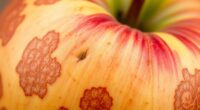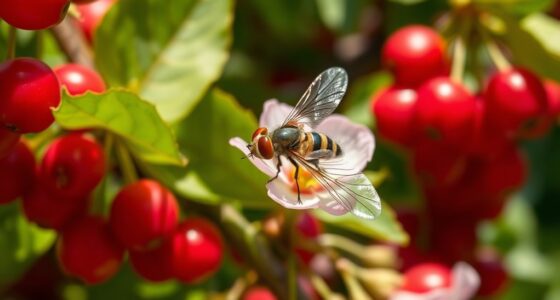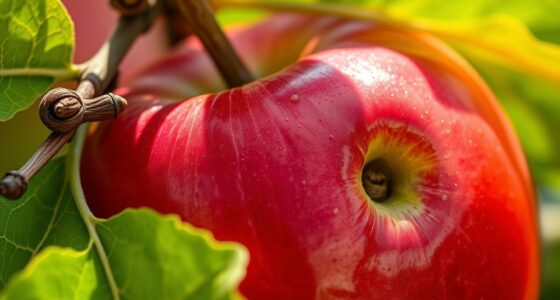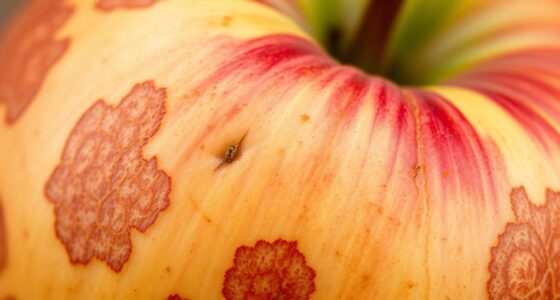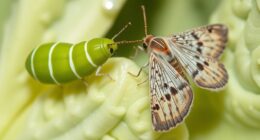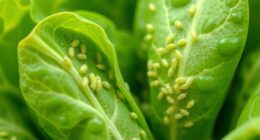Carpenterworms and clearwing borers are common orchard pests that bore into trunks and branches, causing structural damage and reducing fruit yields. You’ll notice signs like exit holes, frass, and tunneling damage, which indicate an infestation. Early detection through regular inspections and proper pest management—such as pruning, removing infested wood, and using biological controls or insecticides—can safeguard your trees. Keep an eye out for these signs to minimize damage and ensure healthy orchard growth.
Key Takeaways
- Carpenterworms and clearwing borers bore into wood, causing structural damage and reducing fruit production.
- Early signs include exit holes, frass, and tunneling, which help in prompt detection.
- Regular orchard inspections and monitoring are essential for early identification and effective control.
- Cultural, biological, and chemical control methods should be integrated for pest management.
- Maintaining orchard health and sanitation minimizes pest infestations and protects tree longevity.
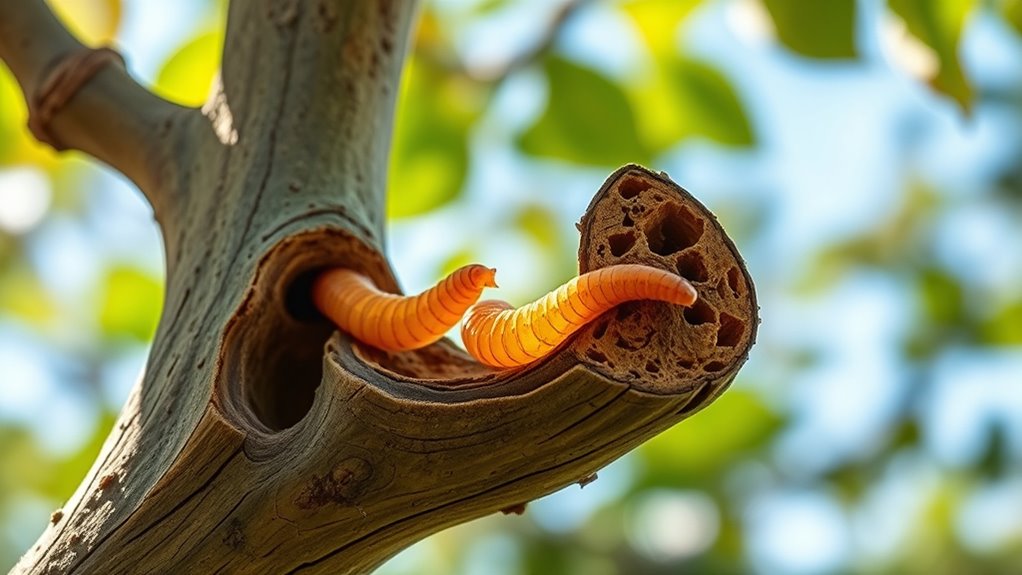
Carpenterworms and clearwing borers are common pests that can cause significant damage to trees and wooden structures. If you own or manage an orchard, understanding how these pests impact your trees is essential for effective pest management and maintaining orchard health. Both pests bore into the wood, disrupting the flow of nutrients and weakening the structural integrity of your trees. Left unchecked, their activity can lead to branch dieback, reduced fruit production, or even tree death.
To stay ahead of these pests, you need to recognize their signs early. Carpenterworms typically tunnel into the trunk and large branches, creating galleries that weaken the wood. You might notice frass (sawdust-like debris) at the base of affected trees or see exit holes on the bark. Clearwing borers, on the other hand, are often identified by their distinctive, wasp-like adult moths that emerge from the tree. During inspection, look for small, round holes in the bark and any signs of frass or tunneling underneath. Early detection allows you to implement pest management strategies before the damage becomes severe.
Early signs include exit holes, frass, and tunneling—spot them to prevent severe damage.
Managing carpenterworms and clearwing borers requires a combination of cultural practices, biological controls, and, when necessary, chemical treatments. Maintaining orchard health through proper pruning, sanitation, and watering creates an environment less favorable for these pests. Removing and destroying infested wood helps eliminate breeding sites, reducing the population. Biological control agents, such as parasitic wasps, can naturally suppress borer populations if introduced or encouraged in your orchard.
Chemical control can be effective but must be used judiciously. Applying insecticides at the right time—typically during the adult moth flight or when larvae are active—maximizes impact. Always follow label instructions and consider integrated pest management (IPM) principles to minimize environmental impact. Regular monitoring and record-keeping help you track pest activity and evaluate the effectiveness of your pest management efforts.
Ultimately, protecting your orchard from carpenterworms and clearwing borers hinges on vigilance and proactive measures. By understanding their life cycle and signs of infestation, you can implement strategies that preserve orchard health, ensure healthy growth, and sustain fruit production. Staying informed and responsive keeps these pests in check, safeguarding your trees and investment for years to come.
Frequently Asked Questions
How Can I Distinguish Carpenterworm Damage From Other Pests?
To distinguish carpenterworm damage from other pests, look for specific damage signs like distinct tunneling patterns and frass buildup around entry points. Use diagnostic techniques such as examining entry holes and burrows closely, and check for sawdust-like debris. Carpenterworms typically create smooth, winding galleries inside wood, unlike other pests. Identifying these signs early helps you accurately diagnose the problem and choose effective control methods.
Are There Natural Predators to Carpenterworm and Clearwing Borers?
Did you know that natural predators play a significant role in controlling pest populations, reducing the need for chemical interventions? Yes, natural predators like certain parasitic wasps and birds target carpenterworm and clearwing borer larvae, making biological control effective. By encouraging these predators, you support eco-friendly pest management strategies, helping to keep pest numbers in check naturally. This approach promotes healthier trees and sustainable orchard practices.
What Are the Long-Term Effects of Borer Infestations on Orchard Health?
Borer infestations can cause long-term damage to your orchard by weakening the root system, leading to decline and reduced nutrient uptake. Over time, this stress results in fruit production loss, diminishing your yield and quality. If you ignore early signs, the infestation worsens, making recovery more difficult. Regular monitoring and prompt treatment are essential to maintaining orchard health and preventing extensive long-term damage caused by these pests.
Can Borer Infestations Spread Between Different Orchard Types?
Yes, borer infestations can spread between different orchard types through inter orchard spread. You should establish infestation barriers, such as proper pruning and sanitation, to reduce this risk. Regular inspections help catch early signs of infestation, preventing the pests from moving between orchards. By maintaining these controls, you can protect your diverse orchard investments and minimize the impact of borer spread across different orchard types.
What Is the Most Effective Way to Prevent Borers in New Plantings?
To prevent borers in new plantings, you should create a strong defense, much like armor. Use mulch barriers around your plants to deter adult insects from laying eggs. Additionally, encourage beneficial insects like parasitic wasps that naturally suppress borer populations. Regular monitoring and prompt removal of infested materials also help. Combining physical barriers with biological control offers the most effective protection, ensuring your orchard stays healthy and borer-free.
Conclusion
Think of carpenterworms and clearwing borers as silent invaders sneaking through the orchard’s defenses. By staying vigilant and implementing proper management, you can block their path like a fortress guard. Regular inspections and timely treatments act as your shield, preventing these pests from causing lasting damage. Remember, your orchard’s health depends on catching these threats early—like catching cracks in a dam before they flood your entire crop. Stay alert, and protect your orchard’s future.

